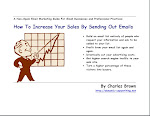Objective White Paper Writing: Learning From Legal Briefs and Academic Papers
Posted by Charles Brown at Saturday, July 05, 2008Why Overly-Biased White Papers Are The "Emporer's New Clothes"
A white paper lives or dies by its perceived objectivity. One whiff of salesmanship and your white paper's reader is out of there.
The reason for this has to do with who white paper readers are and why they read them.
These people are decision makers tasked with doing extensive due diligence before giving the green light on a major transaction. They view a well-written (and objective) white paper as a necessary tool to help them with this due diligence. They accept that the paper has a bias, but also depends on it for information.
To reach (and influence) these decision makers, your white paper must be seen as a trusted resource. The information it provides must be painstakingly truthful, even if it means admitting your product's faults and limitations. (Incidentally, these minor admissions may just be the most persuasive aspect of persuasive writing. See my article Sell More With Ethical Marketing for more information on how to do this.)
And yet, from your point of view, a white paper must still move a decision maker toward a favorable decision. It is still a persuasive device.
One thing that helps me balance these needs for objectivity and persuasion, is my background as an attorney when I had to write legal briefs. A legal brief is a lot like a white paper except that it is written for a judge. Judges, like the decision makers mentioned earlier, rely on briefs to give them the information they need to make their rulings.
They understand that a brief is a written argument, but they expect sound reasoning based upon the law and evidence when making that argument.
Somewhere back in college I found a small book on writing English essays that gave me a formula I used all through law school and in my legal practice when writing legal briefs. And I use it now when writing white papers.. (I no longer have the book and don't remember the author's name, so I cannot give it the attribution it deserves).
First, according to this formula, I acknowledge the opposing point of view with a sentence like, "Although ________ ."
Then, I state my opinion (the thesis statement) with a sentence like, "Nevertheless ___________ ."
And finally, I offer support for my position with, "Because ________."
These three sentences were the outline for every legal paper or brief I ever wrote and it remains a bare bones outline for my white papers today.
Now recently I found a book that expands this argumentative framework idea beyond my simple formula, and I think this book will be a very good resource for white paper writers.
The book is titled, "They Say / I Say" by Gerald Graff and Cathy Birkenstein. It is written for academic writers who must author academic papers. One reviewer of this little book called it the "Strunk and White of academic writing."
What I found particularly relevant to white paper writers are the templates (much like my formula) listed in the back of the book. In fact, "They Say / I Say" grew out of a series of templates Cathy Berkenstein developed in a writing course she taught.
White papers, like legal briefs and scholarly papers and articles, must interact with opposing ideas in order to get readers on board with a different idea.
For example, here are some of Ms. Berkenstein's templates (note that some of these are written in the first person, which would need to be changed in a white paper):
"While it is true that ____, it does not follow that ____."
"By focusing on ____, X overlooks the problem of ____."
"Although I grant that _____, I still maintain that ____."
"X is right that ____, but she seems on more dubious ground when she claims that _____."
So the point here is that objective writing must acknowledge other points of view, and the strengths they present, before they can be challenged and replaced with your own positions.
Your competitors' products have strengths and your own are not perfect. Get these matters out into the open and lay them on the table right away. When you do this , you build trust with the person reading your white paper that cannot be easily shaken later on.
Too many white paper writers try to ignore their competitors' strengths and their own products' limitations, and hope the reader will not notice. Unfortunately, this tactic is a lot like the parable of the "Emperor's New Clothes." The truth is out there for all to see, even if no one wants to talk about it.
COPYRIGHT © 2008, Charles Brown
Labels: white papers
Subscribe to:
Post Comments (Atom)



0 comments:
Post a Comment